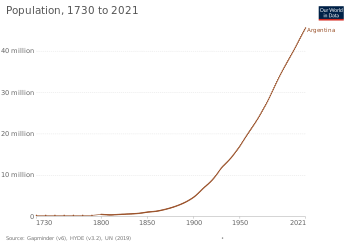Demographics of Argentina
[5] The percentage of senior citizens in Argentina has long been second only to Uruguay in Latin America and well above the world average, which is currently 9.8%.
Eight other provinces each have over one million people: Mendoza, Tucumán, Salta, Entre Ríos, Misiones, Corrientes, Chaco, and Santiago del Estero.
[17][18] Most of these European immigrants settled in the cities which offered jobs, education and other opportunities enabling them to enter the middle class.
Many also settled in the growing small towns along the expanding railway system and since the 1930s many rural workers have moved to the big cities.
[19] Urban areas reflect the influence of European immigration, and most of the larger ones feature boulevards and diagonal avenues inspired by the redevelopment of Paris.
Argentine cities were originally built in a colonial Spanish grid style, centered on a plaza overlooked by a cathedral and important government buildings.
Many still retain this general layout, known as a damero, meaning checkerboard, since it is based on a pattern of square blocks.
The city of La Plata, designed at the end of the 19th century by Pedro Benoit, combines the checkerboard layout with added diagonal avenues at fixed intervals, and was the first in South America with electric street lighting.
Argentina's fertility decline began earlier than in the rest of Latin America, occurring most rapidly between the early 20th century and the 1930s and then becoming more gradual.
According to the 1914 national census, 30% of Argentina's population was foreign-born, including 50% of the people in the city of Buenos Aires, but foreigners were only 2% in the provinces of Catamarca and La Rioja (North West region).
[17] Genetic ancestry of the average Argentine gene pool according to Caputo et al. (2021) using X-DIPs (matrilineal).
This is without prejudice that more than half of the population has at least one indigenous ancestor, although in most cases family memory lost that origin.
The 1813 Assembly abolished slavery and led to the Freedom of Wombs Law of 1813, which automatically freed slaves' children at birth.
Also there is a debate, among the historians, as to whether or not Bernardino Rivadavia, the first president of the United Provinces of the Río de la Plata (Present Argentina) had African ancestors.
[45] As with other areas of new settlement such as Canada, Australia, the United States, Brazil, and New Zealand, Argentina is considered a country of immigrants.
Thousands of immigrants also came from France, Germany, England, Portugal, Brazil, Switzerland, Wales, Scotland, Poland, Albania, Yugoslavia, Czechoslovakia, the Austro-Hungarian Empire, the Ottoman Empire, Russia, Ukraine, Denmark, Sweden, Finland, Norway, Belgium, Luxembourg, the Netherlands, Romania, Bulgaria, Armenia, Greece, Lithuania, Estonia, and Latvia.
[48][49] Thousands of immigrants also came from France (notably Béarn and the Northern Basque Country), Germany, Switzerland, Denmark, Sweden, Norway, Greece, Portugal, Finland, Russia and the United Kingdom.
Many Argentines also speak other European languages (Italian, German, Portuguese, French, Welsh, Swedish and Croatian, as examples) due to the vast number of immigrants from Europe that came to Argentina.
Young people have become accustomed to English through movies and the Internet, and knowledge of the language is also required in most jobs, so most middle-class children and teenagers now speak, read and/or understand it with various degrees of proficiency.
[10] There are sources of around one million Levantine Arabic speakers in Argentina,[63] as a result of immigration from the Middle East, mostly from Syria and Lebanon.
There is a prosperous community of Argentine Welsh-speakers of approximately 25,000[66] in the province of Chubut, in the Patagonia region, who descend from 19th century immigrants.
A study from 2010 found that approximately 11% of Argentines are non-religious, including those who believe in God, though not religion, agnostics (4%) and atheists (5%).








